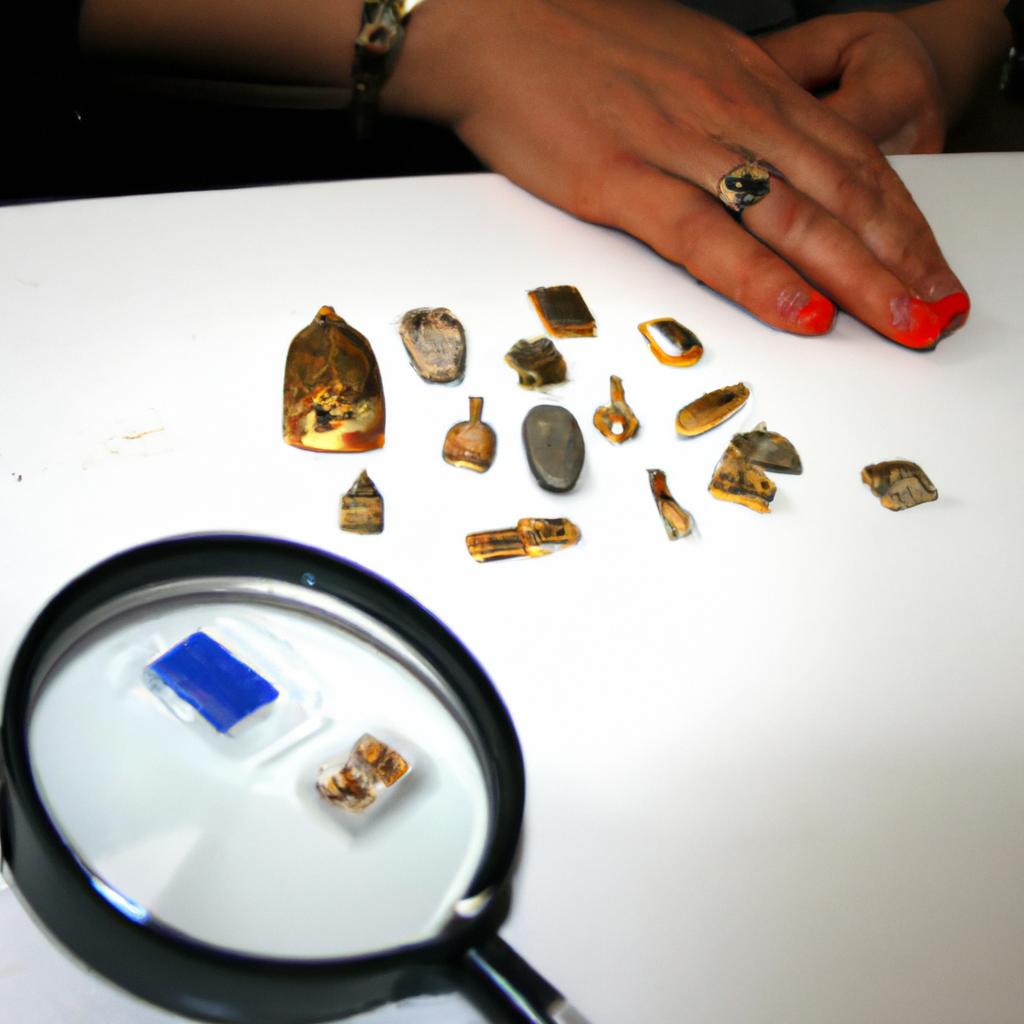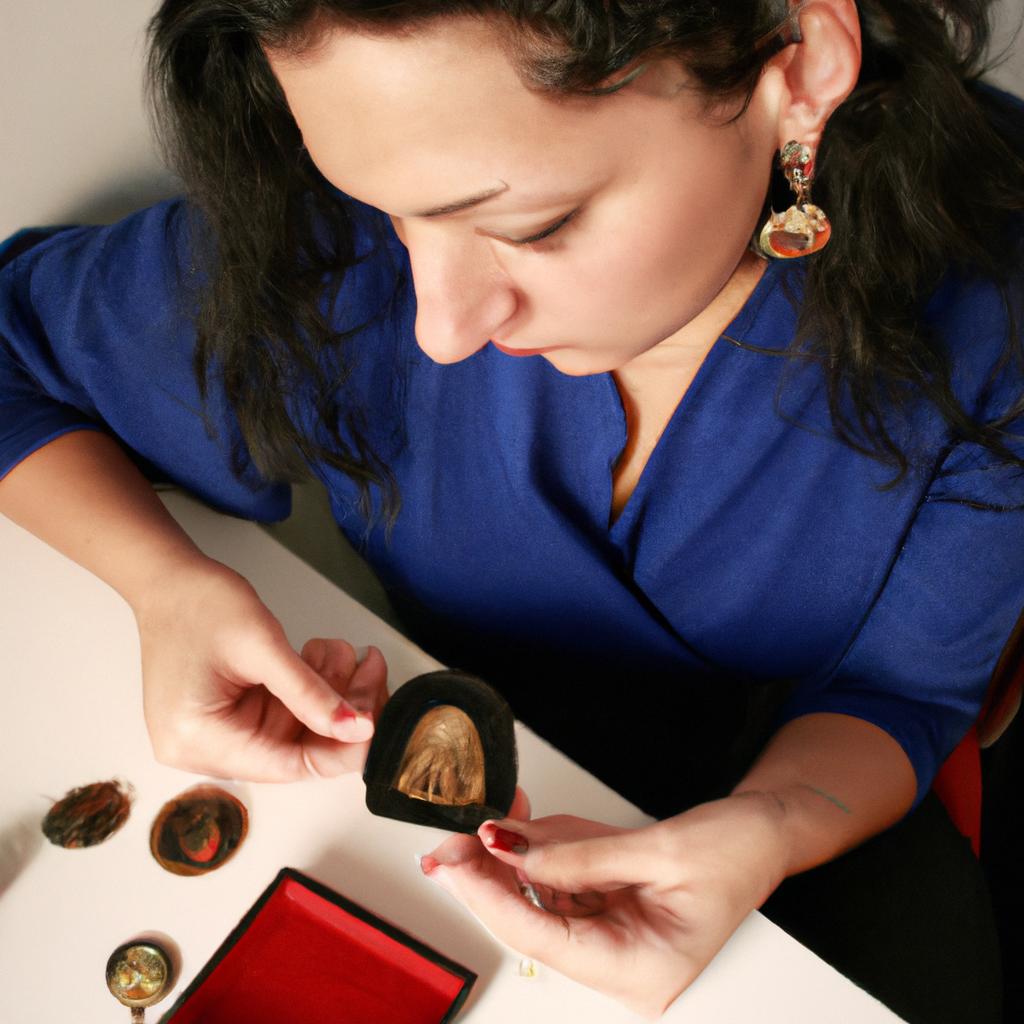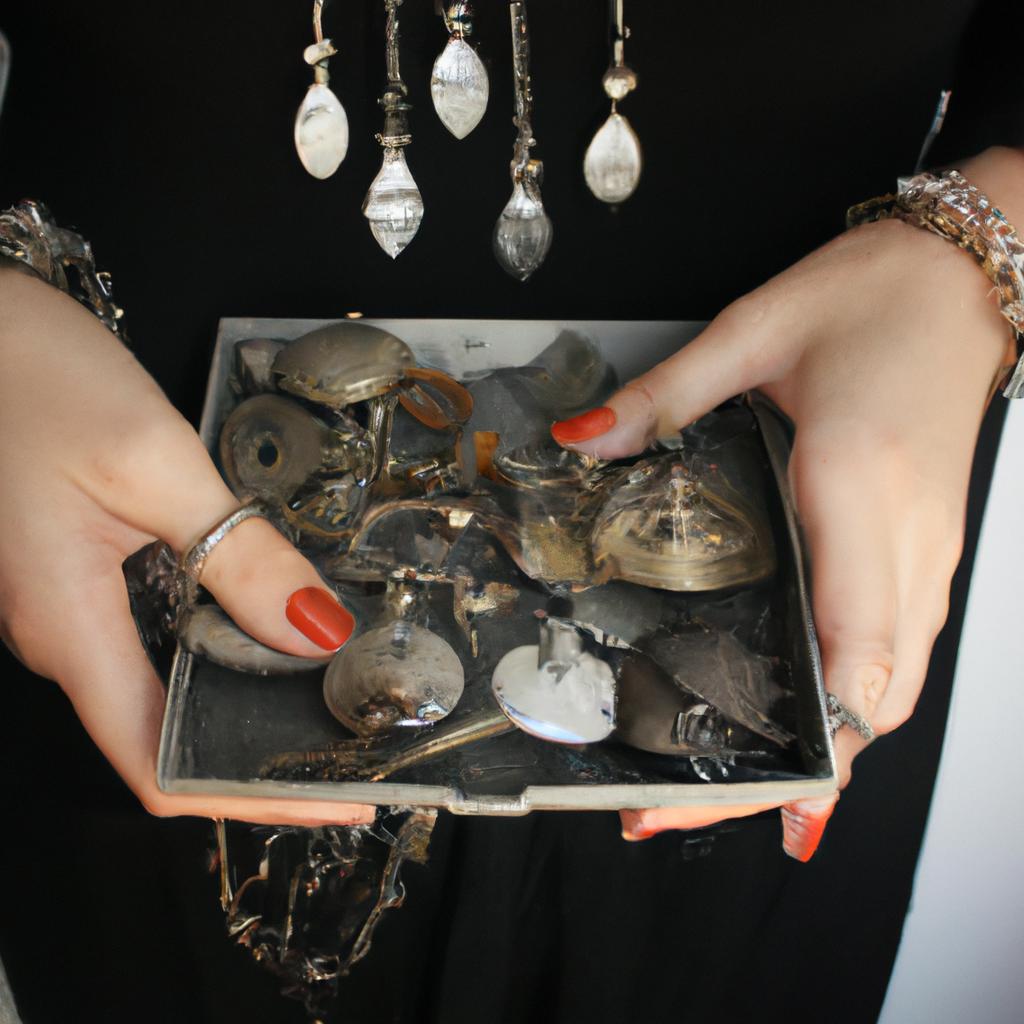Techniques Unveiled: The Intriguing History of Jewelry
The art of jewelry-making has captivated human societies for centuries, becoming an integral part of various cultures across the globe. From ancient civilizations to modern times, this intricate craft has not only served as a means of adornment but also held deeper symbolic and cultural significance. To grasp the essence and evolution of jewelry techniques, let us delve into an intriguing case study – the craftsmanship behind Egyptian amulets.
In ancient Egypt, amulets were treasured objects believed to possess protective powers against evil forces. These small ornaments took on diverse forms such as scarabs, ankhs, or wedjat eyes and were meticulously crafted using various techniques unique to their time. For instance, one prominent technique employed by Egyptian artisans was granulation – the process of attaching tiny gold beads onto a metal surface through soldering. This method required exceptional skill and precision, showcasing the advanced level of craftsmanship achieved during that era. By unraveling the history and intricacies behind these remarkable pieces, we can gain insight into the captivating world of jewelry making throughout different periods in human civilization.
As we embark on this exploration into the fascinating history of jewelry techniques, it is essential to understand that its allure extends far beyond mere aesthetics. Jewelry has served as a reflection of social status, a means of communication, and a way to express cultural identity throughout history. The techniques employed in jewelry-making not only highlight the craftsmanship of artisans but also reveal the values and beliefs of the societies they belonged to.
From ancient Egypt to Mesopotamia, Greece to Rome, and beyond, each civilization developed its own unique methods and styles in jewelry creation. These techniques included casting, filigree, enameling, stone setting, and many others. Each method required specialized skills and tools that were passed down through generations, ensuring the preservation of these precious art forms.
Furthermore, as time progressed and trade routes expanded, different cultures began to influence one another’s jewelry techniques. For instance, during the Renaissance period in Europe, Italian goldsmiths introduced new techniques such as Millefiori glasswork and gemstone cutting that revolutionized jewelry design across the continent.
In modern times, advancements in technology have opened up new possibilities for jewelry-making. Computer-aided design (CAD) allows designers to create intricate pieces with precision and accuracy. Laser cutting and 3D printing have also made their way into the industry, enabling innovative designs that were once unimaginable.
The captivating history of jewelry techniques reminds us of the enduring human fascination with beauty and adornment. It serves as a testament to our creativity and ingenuity throughout the ages. By exploring this rich heritage, we can gain a deeper appreciation for the artistry behind every piece of jewelry we wear today.
Ancient Origins: The Birth of Adornment
Imagine a bustling marketplace in ancient Mesopotamia, where merchants from different civilizations gather to trade their goods. Among the array of items on display, one particular object catches your eye—a beautifully crafted necklace adorned with precious gemstones and intricate goldwork. This stunning piece of jewelry is not just an accessory; it tells a tale of human creativity, cultural expression, and social status. Welcome to the fascinating world of ancient jewelry.
From the earliest known civilizations to modern times, humans have been fascinated by adorning themselves with wearable art. Jewelry has served multiple purposes throughout history—symbolizing wealth and power, expressing religious beliefs, serving as a protective talisman, or simply enhancing personal beauty. To understand the origins of this timeless tradition, we must delve into the archaeological record and explore how early societies approached adornment.
The desire for personal ornamentation dates back thousands of years. Archaeological discoveries reveal that even our prehistoric ancestors sought ways to embellish their bodies using materials such as shells, animal teeth, feathers, and bones. As humanity progressed and developed more sophisticated tools and techniques, new possibilities emerged for crafting elaborate pieces made from diverse materials like gold, silver, copper, gems, glass beads, ivory, and pearls.
To truly appreciate the allure of ancient jewelry and its significance within various cultures around the world, let us consider four compelling aspects:
- Cultural Diversity: A reflection of distinct traditions across regions
- Technological Advancements: An indicator of craftsmanship evolution
- Social Differentiation: A symbol of hierarchy within communities
- Artistic Expression: A medium through which stories are told
By examining these dimensions within each civilization’s unique context—their customs, technologies employed in jewelry making processes (such as casting or filigree work), societal structures—and studying surviving artifacts found at archaeological sites worldwide alongside textual evidence when available—we gain insight into how ancient peoples perceived and valued adornment.
As we delve further into history, the next section will explore how jewelry began to acquire symbolic significance in ancient civilizations. From Mesopotamia and Egypt to Greece and Rome, the evolution of jewelry not only mirrored societal changes but also became an integral part of religious practices, cultural identity, and personal expression—a trend that continues to this day.
Symbolic Significance: Jewelry in Ancient Civilizations
Building upon the ancient origins of jewelry, civilizations across the globe began to recognize its symbolic significance. From royal families to commoners, individuals embraced jewelry as a means of self-expression and cultural identity. One notable example is the intricate gold necklaces worn by Egyptian pharaohs, showcasing their wealth and power. As we delve into the world of ancient civilizations, let us explore how different cultures utilized jewelry for various purposes.
The use of jewelry in ancient civilizations can be categorized into four main areas:
-
Social Status: Jewelry served as a visible indicator of one’s social standing within society. In Mesopotamia, for instance, both men and women adorned themselves with elaborate pieces made from precious metals like gold and silver. The more extravagant the jewelry, the higher an individual’s status was perceived to be.
-
Religious Beliefs: Many ancient societies believed that certain types of jewelry held spiritual or supernatural powers. For example, in Ancient Greece, people wore amulets featuring gods or goddesses to protect themselves from harm or bring them good fortune. Similarly, in Mesoamerican cultures such as the Aztecs and Mayans, jade jewelry was considered sacred and associated with fertility and life.
-
Cultural Identity: Jewelry played a crucial role in expressing cultural heritage and traditions. Native American tribes crafted intricate beadwork designs unique to their respective communities. These patterns often conveyed stories passed down through generations and symbolized tribal affiliations.
-
Personal Adornment: Beyond societal roles and beliefs, individuals also used jewelry simply for personal adornment – a way to enhance their appearance or display personal style preferences. Roman women would wear earrings made from pearls or gemstones as fashionable accessories while Chinese nobility adorned themselves with jade ornaments as a sign of elegance.
| Civilization | Main Use of Jewelry |
|---|---|
| Egypt | Displaying Power |
| Mesopotamia | Demonstrating Status |
| Ancient Greece | Spiritual Protection |
| Mesoamerican Cultures | Cultural Symbolism |
| Native American Tribes | Tribal Identity |
| Roman Empire | Fashionable Accessory |
| Ancient China | Elegance and Prestige |
By understanding the multifaceted roles jewelry played in ancient civilizations, we gain insights into their values, beliefs, and artistic expressions. As we move forward to explore the Renaissance period’s impact on jewelry design, we witness an evolution that transcends time and continues to shape this timeless art form.
Continuing our journey through history, let us now delve into the vibrant world of Renaissance Jewelry.
Artistic Evolution: Renaissance Jewelry
Transitioning from the symbolic significance of jewelry in ancient civilizations, we now delve into the captivating era of Renaissance jewelry. To understand this period’s artistic evolution, let us explore its unique characteristics and examine a hypothetical case study showcasing the allure of Renaissance craftsmanship.
During the Renaissance, jewelry became more than just an adornment; it transformed into a form of self-expression and status symbol. The intricate designs were meticulously crafted by skilled artisans who sought to capture the essence of beauty through their creations. One such example is the elaborate necklace commissioned by a wealthy noblewoman. This masterpiece featured an array of gemstones set within delicate gold filigree work, reflecting both opulence and refinement.
To fully grasp the impact of Renaissance jewelry on society, consider these emotional responses evoked by its remarkable features:
- A sense of awe at the intricacy and attention to detail displayed in each piece
- Admiration for the skill and artistry required to create such extraordinary works
- Fascination with how each jewel was carefully chosen for its color symbolism or astrological properties
- Envy towards those fortunate enough to possess these exquisite jewels as a reflection of their wealth and social standing
The magnificence of Renaissance jewelry can be further appreciated through this table showcasing some notable examples:
| Piece | Description | Materials |
|---|---|---|
| Medici Necklace | Intricately woven strands adorned with pearls | Gold, pearls |
| Papal Tiara | Jeweled headdress worn by Popes | Gold, gemstones |
| Borghese Earrings | Chandelier-style earrings embellished with diamonds | Gold, diamonds |
| Florentine Ring | Elaborate ring featuring a large colored gemstone | Gold, gemstone |
In exploring the fascinating world of Renaissance jewelry, one cannot help but be captivated by its artistic evolution. The era’s emphasis on intricate design, meticulous craftsmanship, and the use of precious materials resulted in breathtaking pieces that continue to inspire awe today. As we transition into the subsequent section about Revolutionary Innovations: Industrial Era Jewelry, we witness how societal changes influenced further transformations in the world of jewelry creation.
Revolutionary Innovations: Industrial Era Jewelry
From Artistry to Industry: The Evolution of Jewelry Design
In the wake of the Renaissance, jewelry design witnessed a remarkable transformation that reflected both artistic ingenuity and societal shifts. One fascinating example is the rise of intricate gemstone settings during this period. For instance, jewelers began experimenting with new techniques such as pavé setting – embedding small diamonds tightly together to create a sparkling surface reminiscent of cobblestones on a street. This innovation not only enhanced the visual impact of jewelry but also showcased the jeweler’s mastery over their craft.
This period also saw significant advancements in manufacturing processes, leading to mass production and increased accessibility of jewelry for individuals from various walks of life. As industrialization took hold, innovative technologies like steam-powered machinery revolutionized the production process. Jewelers could now employ these tools to create intricately designed pieces at a faster pace while maintaining consistent quality.
The transition from artisanal creation to industrial manufacture brought about several changes within the industry:
- Standardization: Mass production enabled the establishment of standardized sizing systems for rings, necklaces, bracelets, and other accessories.
- Accessibility: With reduced costs due to streamlined manufacturing processes, high-quality jewelry became more affordable for a broader range of consumers.
- Novel materials: Industrialization opened up opportunities for experimentation with unconventional materials such as celluloid or Bakelite alongside traditional precious metals and gemstones.
- Reproducibility: Machine-made jewelry allowed for easy replication of popular designs, making it possible for people across different regions to wear similar styles.
| Advancements | Impact |
|---|---|
| Standardization | Ensured better fit and ease when purchasing jewelry |
| Accessibility | Increased options available regardless of socioeconomic status |
| Novel Materials | Provided unique aesthetic choices beyond traditional materials |
| Reproducibility | Promoted widespread trends and cultural exchange |
As we delve further into the history of jewelry, it becomes evident how technological innovations shaped its evolution from a primarily artisanal craft to an industry fueled by mass production. The shift in manufacturing techniques and the introduction of novel materials not only transformed jewelry design but also influenced its accessibility, catering to a broader audience. In our next section on “Cultural Influences: Jewelry in Different Regions,” we will explore how various cultures infused their own distinct perspectives into jewelry creation throughout history.
Cultural Influences: Jewelry in Different Regions
Cultural Influences: Jewelry in Different Regions
Building upon the revolutionary innovations of the industrial era, jewelry continued to evolve under diverse cultural influences. From intricate designs rooted in ancient traditions to bold and contemporary statements reflecting modern aesthetics, jewelry has always been a reflection of human creativity and expression.
Throughout history, various regions have contributed distinct styles and techniques that have shaped the world of jewelry. One fascinating example is the rich tradition of Indian jewelry. Known for its opulence and intricacy, Indian jewelry showcases an exquisite blend of precious gemstones such as emeralds, rubies, and diamonds set in elaborate gold or silver settings. The craftsmanship involved in creating these pieces often involves meticulous handwork passed down through generations.
To delve into the diversity further, let us explore some key cultural influences on jewelry across different regions:
-
Egyptian Influence:
- Symbolism: Ancient Egyptians believed that specific gemstones held mystical powers and used them not only for adornment but also for protection.
- Materials: Gold was highly revered by the Egyptians due to its association with divinity and eternal life.
- Techniques: Intricate filigree work, enameling, and stone setting were commonly employed in Egyptian jewelry-making.
-
Chinese Influence:
- Symbolism: Traditional Chinese culture places great importance on symbolism within their jewelry design. For instance, dragons symbolize power while phoenixes represent grace and beauty.
- Materials: Jade holds immense significance in Chinese culture as it represents prosperity and good luck.
- Techniques: Filigree work combined with vibrant colors from enameled accents are characteristic features seen in Chinese jewelry.
-
Native American Influence:
- Symbolism: Native American tribes often incorporate nature-inspired symbols like feathers, animals, and natural elements into their designs to convey spiritual meanings.
- Materials: Turquoise plays a prominent role in Native American jewelry as it is considered sacred and represents protection against evil forces.
- Techniques: Intricate beadwork, silver overlay, and hand-stamping are commonly used techniques in Native American jewelry-making.
| Region | Symbolism | Materials | Techniques |
|---|---|---|---|
| Egyptian | Mystical powers | Gold, gemstones | Filigree work, enameling |
| Chinese | Symbolic representation | Jade | Filigree work, enameled accents |
| Native American | Spiritual meanings | Turquoise | Beadwork, silver overlay, hand-stamping |
As we can see from these examples of cultural influences on jewelry across different regions, the artistry and craftsmanship reflect not only aesthetic preferences but also deeply rooted beliefs and traditions. The evolution of such diverse styles continues to captivate both artisans and enthusiasts alike.
With a rich foundation established by historical innovations and cultural influences in jewelry design, it is now time to explore contemporary trends that shape modern-day adornments.
Contemporary Trends: Modern Jewelry Design
Continuing our exploration of the fascinating history of jewelry, we now delve into the diverse cultural influences that have shaped its evolution across different regions. To illustrate this, let us consider the case study of ancient Egypt – a civilization renowned for its exquisite and symbolic jewelry.
Ancient Egyptians regarded jewelry as more than mere adornment; it held deep religious and metaphysical significance. The use of precious materials such as gold, lapis lazuli, and turquoise reflected their belief in the divine nature of these elements. One striking example is the iconic burial mask of Tutankhamun, adorned with intricate goldwork and precious gemstones. This masterpiece not only showcased technical excellence but also embodied the spiritual beliefs and social status associated with Egyptian royalty.
The influence of culture on jewelry design can be observed worldwide throughout history. Here are some noteworthy characteristics found in various regions:
- In India, intricate filigree work using silver or gold wire is prominent.
- Native American tribes often incorporate natural materials like feathers, shells, and turquoise into their designs.
- Chinese artisans are known for their mastery of jade carving techniques.
- African cultures embrace boldness through large statement pieces made from vibrant beads or metals.
To further understand the diversity in jewelry design across cultures, let us examine a comparison table showcasing key features:
| Region | Materials | Techniques | Symbolism |
|---|---|---|---|
| Ancient Egypt | Gold, Gemstones | Granulation, Engraving | Divine Status |
| India | Silver, Gold | Filigree Work | Spiritual Significance |
| Native America | Feathers, Shells | Beadwork | Connection to Nature |
| China | Jade | Carving | Wisdom and Prosperity |
By appreciating these distinct cultural influences on jewelry design, we gain a deeper understanding of the rich tapestry that encompasses this art form. The interplay between materials, techniques, and symbolism not only showcases the creativity and craftsmanship of different civilizations but also offers insights into their beliefs, traditions, and values.
Incorporating diverse cultural elements into jewelry design has become increasingly prevalent in modern times. Contemporary designers draw inspiration from various regions to create unique pieces that celebrate our global heritage while embracing individuality. As we explore the contemporary trends in modern jewelry design, let us witness how these influences continue to shape this timeless art form for generations to come.
 Shanes Jewelry
Shanes Jewelry



